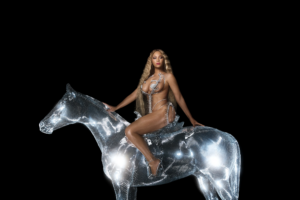Lana Del Rey is feeling her age.
More than a decade after the release of her first studio album, Elizabeth Grant, the singer-songwriter known as Lana Del Rey, has found her most experimental sound yet with Did you know that there’s a tunnel under Ocean Blvd (2023). Her tenth studio album, which dropped on March 24, demonstrates vocal maturity paired with a laid-back sound. Balanced between the memory of her old sound and a taste for new directions, the album also has a quality of liveness not seen in Del Rey’s past projects, mixing sound effects and radio-style interludes to create a highly visual, cinematic experience. Fans of Ethel Cain will enjoy the haunting visions of rural America, religious imagery, and youth in decline that Del Rey presents with Ocean Blvd.
Like much of Del Rey’s catalog, Ocean Blvd uses the metaphor of physical boundaries to explore the hazy line between sexual liberation and sexual exploitation. Through her somber yet alluring presentation, Del Rey both romanticizes the use of sex for self-destruction and conveys the emptiness and confusion of identity that accompanies that act. The album demonstrates her unfailing aptitude for creating poetic lyrics that appeal because they aren’t straightforward—they reflect the constant confusion that comes with trying to pin down who you are and why you act the way you do.
In past releases, Del Rey has used these lyrics about physical boundaries to discuss the blurring of social and emotional boundaries—blue banisters, training yards, the Mariners Apartment Complex. And while a tunnel under Ocean Boulevard suggests a hidden complexity to the physical plane, the album also demonstrates an added layer of complexity in its production. Her exploration of boundaries has bled into the structure of the songs themselves, using featured interludes to buttress dynamic singles and creating jarring tone shifts in “The Grants,” “A&W,” and “Taco Truck x VB.” Transcending the boundaries that come with the close and succession of each song, Del Rey also intersperses similar themes between separate tracks, such as the hook, “You can braid my hair” that links “Fishtail” and “Peppers.” The range of styles and sounds that Del Rey juggles brush up on each other in the listening experience of Ocean Blvd.
The album opens with a vocal warmup that segues into a piano ballad with “The Grants,” which establishes the gothic Americana tone of the album. Whereas Del Rey’s past projects featured mid-century suburban and urban landmarks like country clubs, station yards, beaches, and racetracks, Ocean Blvd has a distinctly rural feel. In contrast to the hard-partying aesthetic of her earlier releases, the singer now speaks of that self-destruction with a sense of distance. Like a teenage wild child mellowed out by age, Del Rey finds the divine in Ocean Blvd, adding a religious and sometimes folksy feel to her songs. The singer layers choral harmonies at the close of “Did you know that there’s a tunnel under Ocean Blvd,” the titular track and lead single, giving the song a religious feel. The eeriest and most clearly religious track is “Judah Smith Interlude,” four minutes of ranting by the eponymous megachurch pastor laid over a simmering piano melody. The interlude plays like a live recording of the singer listening to a radio sermon; you can hear Del Rey’s laughter and asides over the shouting preacher.
“Judah Smith Interlude” is flanked by two standouts on the album: “A&W” and “Candy Necklace.” The former is a dreamy, seven-minute single released ahead of the album on Valentine’s Day, featuring Del Rey’s sultry vocals layered over quick-moving, haunting piano. The warbling keys give the track an old west quality; the notes fall like sunbeams through dusty air. The pace at which the notes move and the absence of any grounding drumbeat keeps the focus on the keys––you can imagine Del Rey at her piano in an empty hall, letting the music fill the air.
In “A&W,” Del Rey’s pitch rises so high that her voice takes on a whisper-like quality, rendering her words nearly indiscernible, yet effectively conveying the vulnerability of her confession. Although Del Rey is known for her lyricism, “A&W” relies on the uniqueness of its instrumental melody to capture the listener, allowing lyrics to fade into the foreground. You have to listen closely to parse what Del Rey’s saying: “Honey look at my hair/ look at the length of it and the shape of my body.” Her simmering vocals indicate the centrality of physical appearance to a feminine coming-of-age story. Through her lyricism, it becomes clear that A&W stands not for the American fast food joint but for “American whore,” by which Del Rey refers to herself. “A&W” also features a dramatic breakdown in the second half of the song, grounded by drumbeat rather than a piano melody. Whereas the first part of “A&W” feels lifted straight from the 1960s, the second half slides into a distinctly 21st century-style production and editing. It features warbling cuts of Del Rey’s vocals mixed with reverberating synths and eccentric sound effects like steam hissing. Listeners familiar with the Jack Antonoff-produced track “Hard Feelings/Loveless” on Lorde’s Melodrama will recognize the producer’s touch in the structure of this song.
“Candy Necklace” relies even more heavily on its musicality than “A&W,” with a piano accompaniment that adds dynamism. By speeding up and slowing down the piano loop, Del Rey uses tempo to diversify the sound rather than introducing a bridge or switching up the chord progression. Del Rey also slides into a softer sound with “Paris, Texas,” that reveals indie folk influences of the likes of Agnes Obel and features pianist SYML. Her guest features are exquisitely selected, ranging from indie artist Father John Misty to pop staple Bleachers (the project of her producer and frequent collaborator Antonoff) to underground rapper Tommy Genesis.
Because all of the album’s singles are featured in the first half of the album, it loses some momentum a little past the halfway point. Ocean Blvd regains its focus with “Fishtail,” a track reminiscent of her 2017 song “Lust for Life” with its moody synths and energy. Del Rey then veers into a tour of her old sounds, and the last three tracks recall hits from past albums. “Fishtail” is immediately followed by “Peppers,” an experimental track anchored in a bass line, a trap beat, and a hook by Tommy Genesis that revisits Lana’s earliest releases but doesn’t quite match the vibe of the rest of the album. It also features the most eclectic mix of sounds and instruments on the record by far, a clear divergence from the piano-based melodies on the rest of the album.
Although Ocean Blvd lacks the well-rounded, no-skip quality of her crowning achievement, Norman Fucking Rockwell! (2019), it is a powerful testament to her lyrical complexity and her skill at playing with memory. The album closer “Taco Truck x VB” mixes her early 2010s drumbeat-centered sound with lyrics from “Venice Bitch,” a single from Rockwell. The choice to end the album with this track perfectly ties the themes of the album––the blurring of boundaries and the ghosts of her past lives––with an internal transition from a melancholic guitar-led melody in ¾ time to a swinging remix of “Venice Bitch” grounded by a trap beat. The hook of the song is, “Calling out bang bang, kiss kiss,” once again marrying violence and sexuality.
With a dynamic blend of old and new styles, Ocean Blvd is Lana Del Rey’s boldest, most experimental release yet.





